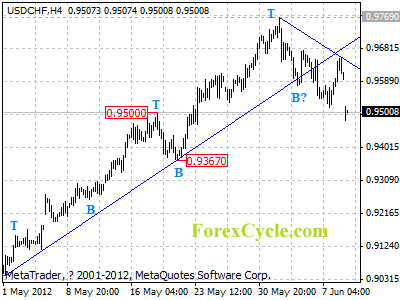Source: ForexYard
The euro fell against several of its main currency rivals on Friday, following another Spanish credit rating downgrade and the news that the country will require a bailout to help its ailing banking sector. After falling over 130 pips during the first part of the day, reaching as low as 1.2434, the EUR/USD was able to stage a slight upward correction to finish out the week at 1.2514. This week, news out of Spain, particularly with regards to the size and scope of the bailout package it needs, has the potential to create heavy market volatility. Additionally, traders can anticipate significant euro movement as investors digest the latest news out of Greece, which is scheduled to hold elections next Sunday.
Economic News
USD – Dollar Benefits from Spanish Credit Downgrade
The US dollar saw upward movement on Friday, as investors shifted their funds to the safe-haven currency following another Spanish credit rating downgrade earlier in the week. The GBP/USD fell over 100 pips during Asian trading, reaching as low as 1.5402 during early morning trading before correcting itself to finish out the week at 1.5472. Against the AUD, the dollar was able to start the day off by gaining close to 90 pips. That being said, the aussie was able to climb back during the European session, eventually recouping all of its earlier losses. The AUD/USD closed the week at 0.9914.
Turning to this week, dollar traders will want to pay attention to several potentially significant economic indicators. On Wednesday, the Retail Sales, Core Retail Sales and PPI figures could cause the USD to fall vs. the JPY if the figures come in below their forecasted levels. Later in the week, the Unemployment Claims and Core CPI figures, followed by the Prelim UoM Consumer Sentiment may lead to market volatility if they do not come in as expected. Should any of the figures disappoint, it could lead to further worries regarding the US economic recovery and whether the Fed is planning to initiate a new round of quantitative easing.
EUR – New Spanish Bailout May Lead to Further EUR Losses
The euro saw a mixed session on Friday, as news that Spain’s credit rating was downgraded caused investors to shift their funds away from the common-currency. Against the JPY, the euro fell as low as 98.51 during the overnight session before staging a slight correction to close the week at 99.46. Against the AUD, the euro fell over 100 pips, reaching as low as 1.2582. The EUR/AUD ended up finishing out the week at 1.2617.
This week, euro traders will want to continue monitoring any developments out of Spain, specifically in reference to the bailout package it needs. Any indication that the banking troubles the country is currently facing are bigger than originally thought could lead to heavy euro losses. Additionally, with Greece getting ready to hold a much anticipated election next Sunday, traders can anticipate news out of the country to generate market volatility. Any signs that anti-austerity political parties could emerge victorious may lead to additional losses for the common-currency.
Gold – Gold Finishes the Week below $1600
Gold saw downward movement throughout Friday’s trading session, following gains made by the US dollar due to concerns about Spanish debt. Typically, the price of gold moves down when the USD is strong, as the precious metal becomes more expensive for international buyers. Gold dropped as low as $1544.44 an ounce before staging a slight upward correction to finish out the week at $1593.13.
This week, gold traders will want to pay attention to a batch of US indicators and how they affect the dollar. Any bullish movement the greenback has against riskier currencies like the euro and Australian dollar could cause gold to extend its downward trend.
Crude Oil – Demand Worries Causes Oil to Turn Bearish
The price of oil fell on Friday, following an increase in investor concerns regarding global demand for the commodity. Additionally, following last Thursday’s speech from Fed Chairman Bernanke the US dollar strengthened, making the cost of crude more expensive for international buyers. Oil finished out the week at $84.10 a barrel.
Turning to this week, events in the euro-zone may influence the direction oil takes. Should investors continue to shift their funds to safe-haven assets as a result of economic and political worries out of Spain and Greece, oil could extend its bearish trend. At the same time, any indications that pro-austerity political parties in Greece may emerge victorious in the upcoming election could result in risk taking in the marketplace. Oil could recoup some of its recent losses in such a case.
Technical News
EUR/USD
Technical indicators on the weekly chart show that this pair is currently range trading, meaning that no defined long-term trend can be predicted at this time. That being said, the daily chart’s Williams Percent Range has crossed over into overbought territory. Traders may want to open short positions, as downward movement could be seen in the near future.
GBP/USD
A bullish cross has formed on the weekly chart’s Slow Stochastic, indicating that this pair could see upward movement in the coming days. In addition, the Bollinger Bands on the daily chart are beginning to narrow, meaning that a price shift could occur in the near future. Opening long positions may be the wise choice.
USD/JPY
While a bullish cross appears to be forming on the weekly chart’s Slow Stochastic, most other long-term indicators show that this pair is in neutral territory. Traders may want to take a wait and see approach, as a clearer trend is likely to present itself in the near future.
USD/CHF
Technical indicators are providing mixed signals for this pair. While the Williams Percent Range on the daily chart is in oversold territory, the weekly chart’s Slow Stochastic has formed a bearish cross. Traders will want to use a wait and see strategy for this pair.
The Wild Card
GBP/AUD
A bullish cross on the daily chart’s Slow Stochastic indicates an upward correction may occur in the near future. This theory is supported by the Williams Percent Range on the same chart, which is currently just above the -90 level. This may be a good time for forex traders to open long positions ahead of possible bullish movement.
Forex Market Analysis provided by ForexYard.
© 2006 by FxYard Ltd
Disclaimer: Trading Foreign Exchange carries a high level of risk and may not be suitable for all investors. There is a possibility that you could sustain a loss of all of your investment and therefore you should not invest money that you cannot afford to lose. You should be aware of all the risks associated with Foreign Exchange trading.
 Tradervox (Dublin) – The euro advanced against most major peers after governments in the region agreed to offer bailout loan to Spain. Spain is the third largest economy in the region and it has encountered its greatest debt crisis since the monetary union was established. It 10-year bond yield has been high touching 6.5 percent in April only 0.5 percent less than the 7 percent reached by Greece, Ireland, and Portugal before they requested for bailout. Spain has been looking for support in recapitalizing some of its banks that have experienced debt crisis.
Tradervox (Dublin) – The euro advanced against most major peers after governments in the region agreed to offer bailout loan to Spain. Spain is the third largest economy in the region and it has encountered its greatest debt crisis since the monetary union was established. It 10-year bond yield has been high touching 6.5 percent in April only 0.5 percent less than the 7 percent reached by Greece, Ireland, and Portugal before they requested for bailout. Spain has been looking for support in recapitalizing some of its banks that have experienced debt crisis.




